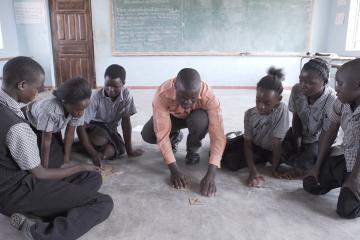
The Evidence Effect: How LMIC governments drive and scale effective poverty reduction policies

Low- and middle-income country (LMIC) governments are at the center of the fight against poverty. Most LMIC governments invest far more in their own social programs—which include health care, education, and social safety nets—than all foreign aid combined. While foreign assistance has been in the spotlight this year, LMIC governments are the ones that make financial commitments, set priorities, and have the mandate and reach to make change stick.
As the executive directors of J-PAL Latin America and the Caribbean (LAC) and J-PAL Southeast Asia (SEA), our partners in government have been deeply committed to finding new ways to tackle enduring challenges. We’ve worked hand in hand with leaders in government who are dedicated to reducing poverty through innovative programs, evaluating the effectiveness of those innovations, and scaling up those that work.
Our partners have shown that the path to sustainable development and poverty alleviation should run through innovative and effective governments around the world—and now more than ever, we should be learning from their efforts.
Governments are proven innovators
Governments already originate many new and creative approaches within their own programs. Testing and refining these innovations through randomized evaluations can sometimes change the entire policy landscape. Take conditional cash transfers (CCTs), in which cash is provided to families on the condition that they invest in the health or education of their children. This approach was developed in Mexico and Brazil in the 1990s, and from the start, the Mexican government worked with researchers to conduct evaluations—which found CCTs to be consistently effective in combating poverty and supporting children.
Based on these results, other governments around the world began to create their own programs, including in Indonesia. Now, over sixty governments worldwide have or have had a CCT program. There have been hundreds of rigorous evaluations measuring their impacts and helping governments learn what works to optimize program design and improve outcomes. This evidence has helped make CCTs a key part of governments' social protection toolkits. Building on the success of CCTs, unconditional cash transfers have also become an increasingly popular evidence-informed tool to reduce poverty and improve families' resilience.
In another case of government innovation here in Indonesia, the government saw that subsidized rice meant for vulnerable families often failed to reach them due to suspected misappropriation by middlemen. To find the most effective of many potential solutions, the government worked with researchers to test different approaches, and a game-changing solution was uncovered. A rapid evaluation found that providing households with information about their eligibility for the subsidy and how much rice they were entitled to was both effective and cost-effective. The evaluation was done quickly to deliver findings in time for budget decisions, and the program was scaled up to reach nearly 15 million households.
What can we do to enable government innovation?
Funders, researchers, and partners can all support government innovation. In our work, we have found a few specific ways to support governments in finding creative solutions.
Presence, trust, and a sustained relationship over the long term are key. In the subsidized rice example from Indonesia above, J-PAL SEA had worked with a government think tank for many years prior to the rapid evaluation. Forward-thinking entities like these are great sources of innovation, as they have more flexibility to try new things, while as a part of government they have existing channels to line ministries.
Listening closely to government priorities and needs, and offering evidence-based ideas that align with these priorities, is a key component to our approach. Sometimes we work with partners in government who are developing new solutions, like in this Indonesia example. Other times inspiration for evidence-informed solutions can come from outside.
Great ideas often come from outside‚ including from other governments and NGOs. Researchers and funders can help governments adapt, test, and scale these innovative models. When considering evidence-based ideas from outside, our government partners take the lead on ensuring new approaches can work within the parameters of the government’s reach and resources, and figuring out how new programs can be integrated in public systems so they can reach many more people. We support by evaluating piloting variations of a program so governments can decide if and how to scale.
Some of the most effective approaches to improving lives and reducing poverty, like Teaching at the Right Level or Graduation programs, were first developed by NGOs outside government and, with the support of funders, researchers, and NGOs, are now being scaled by governments worldwide—but this is not an automatic process. By involving public leaders, researchers, NGOs, and local communities at every stage, we can help ensure that solutions are sustainably embedded within public systems.
In Brazil, for example, we are exploring how governments can adapt and scale external innovations to improve early childhood education. Through a four-year partnership between the Bracell Foundation, Itaú Social, J-PAL LAC, and multiple state and municipal education departments, we aim to identify, implement, and rigorously evaluate promising preschool programs with the potential for large-scale adoption—leading to improvements in persistent educational disparities across Brazil’s diverse regions. Itaú Social is consolidating lessons to guide future implementation.
Support governments learning from each other. In Indonesia last year, J-PAL SEA brought together government officials from Egypt and Indonesia to share lessons and innovative practices for building more effective social protection programs. J-PAL MENA and the Egyptian government’s health insurance authority recently hosted Chilean officials to share their experience with health insurance benefit design as part of a learning series about designing effective universal health insurance programs. These exchanges show how much potential there is for LMIC governments to not only learn from the evidence base, but to learn from each other.
Fostering innovation through embedded labs and long-term partnerships
One effective and collaborative way to build trust, adapt and test new ideas, and enable shared learning is through embedding staff or building an embedded lab. Labs embedded in government institutions are centers of innovation that enable continuous experimentation and learning from within the system itself, aligned with national priorities and able to survive changes in personnel or administrations.
Diagnosing challenges and identifying and scaling solutions is not a linear process. The embedded model allows all of this to happen much, much faster, and time is of essence for governments.
Here in LAC, we helped set up J-PAL’s first embedded lab within Peru’s Ministry of Education, alongside Innovations for Poverty Action, to systematically test and scale evidence-informed, low-cost educational solutions, some of which have been scaled up. By institutionalizing innovation and evidence use within the Ministry, MineduLAB has fostered a culture of continuous learning and adaptation. The success of MineduLAB has inspired the creation of similar labs; today, we have more than 37 embedded labs and close research and policy partnerships with governments around the world.
In Indonesia, we at J-PAL SEA have worked closely with the Government of Indonesia for over a decade with close engagements across several ministries and many research partnerships. The Egypt Impact Lab in the Ministry of Planning and Economic Development and the Morocco Innovation and Evaluation Lab provide models from the MENA region, and in India, the Ministry of Rural Development recently signed an MoU to launch a Gender Impact Lab. In Mexico, we’re helping develop new labs in the Secretariat of Planning of Querétaro and the National Institute of Housing, and in Benin, a new partnership with the Ministry of Development will bring evidence-informed ideas to help achieve national development priorities.
Looking ahead
As the global development landscape shifts and budgets tighten, funders and partners should support low- and middle-income country governments in taking an evidence-informed approach to reducing poverty and improving their citizens’ lives. Their innovation, evaluation, and capacity to scale are the foundation of sustainable poverty reduction.
Embedded labs and long-term partnerships are just one way to support governments’ efforts to innovate and scale effective programs. In the next installment of The Evidence Effect, you’ll hear from our colleagues Iqbal Dhaliwal and Tithee Mukhopadhyay about strategies for building stronger government institutions to deliver essential public services and improve efficiency in program delivery to help people most in need.



